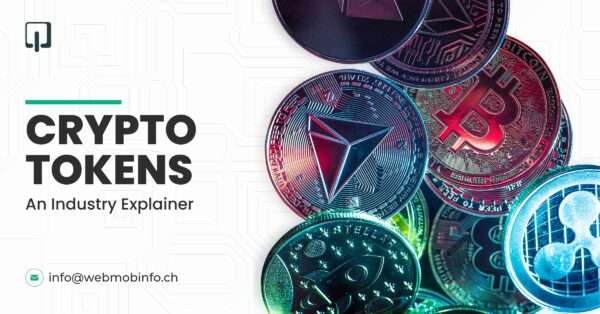What’s the first thing that comes to mind when discussing cryptocurrency?
Bitcoin, Ethereum, right?
Cryptocurrencies like them are the native currency of a blockchain that can be exchanged for a fiat currency or has a worth. You can conveniently trade Bitcoin for its value at any crypto-exchange platform.
However, things are different with crypto tokens.
Crypto tokens are digital ” tickets” or “coupons” representing something valuable. This could be project ownership, service access, or a stake in an investment powered by blockchain.
Cryptocurrencies like Bitcoin or Ethereum are digital money used within their own blockchain, while crypto tokens, which represent diverse items, are created or issued on top of these chains.
Before proceeding further into the topic, let’s understand the concept from its base.
Understanding Crypto Tokens & Crypto Coins
When starting with blockchain jargon, it’s crucial to understand the difference between digital assets, crypto coins, and tokens. These terms are often used interchangeably, but they aren’t identical. Retrospectively, a digital asset is a non-tangible asset created, exchanged, and stored in digital format. Regarding blockchain, digital assets consist of cryptocurrency, i.e., crypto coins and tokens.
Tokens and crypto coins are distinct subclasses of digital assets that use cryptography. This sophisticated encryption method eliminates the chance of double-spending or counterfeiting and guarantees the legitimacy of crypto assets. Tokens are created as part of a platform built on an existing blockchain, such as the ERC-20 tokens that comprise the Ethereum ecosystem. In contrast, crypto coins, such as BTC or ETH, are the native asset of a blockchain. This is the main distinction between the two classes of digital assets.
Knowing More About Cryptocurrency
As we discussed earlier, cryptocurrencies are like the native asset of a blockchain network. They can be purchased, traded, and stored in a wallet. You can directly buy any cryptocurrency from an exchange by paying its exchange value to your bank. Cryptocurrency’s usage isn’t just limited to transactional exchanges; you can pay network fees, incentivise your users, and keep the network running.
One can easily distinguish a cryptocurrency from a crypto token if it exhibits the following characteristics:
- No single entity or government controls it, i.e., true decentralization.
- It uses advanced cryptography to protect transactions and enhance security.
- Accessible worldwide with an internet connection; talk about going global.
- Transactions are recorded on a public blockchain or other Distributed Ledger Technology (DLT) making it transparent.
- Often, it has a capped supply, increasing potential value and limiting its reach.
Importance of Crypto Token
Blockchain-based projects generate tokens, often known as crypto tokens, on preexisting blockchain networks. Although these digital assets frequently function flawlessly with the network’s cryptocurrency, they are fundamentally distinct from one another.
Tokens are created by platforms that operate on top of specific blockchains, whereas cryptocurrencies are the native currency of such blockchain protocols. Ether (ETH), for instance, is the native cryptocurrency of the Ethereum blockchain. The native currency of the Ethereum blockchain is ether, but various tokens also make use of it. A few cryptocurrency tokens created with Ethereum are CryptoKitties, LINK, COMP, and DAI. These tokens can be used for several things on their platforms, including gaming, accessing platform-specific services, and participating in decentralized finance (DeFi) procedures.
Crypto tokens are created using several widely accepted token standards, most based on Ethereum. The two most popular standards are ERC-721, which enables non-fungible tokens (NFTs), which are distinct and cannot be substituted with other tokens of a similar nature, and ERC-20, which permits the creation of tokens that can interact inside Ethereum’s ecosystem of decentralized apps. Thousands of ERC-721 tokens and hundreds of distinct ERC-20 tokens are in use as of 2020. The number of different tokens is expected to expand quickly due to the ongoing creation of new tokens to address new blockchain applications.
Crypto tokens have the same value as cryptocurrencies and can be exchanged. They may also be made to resemble conventional digital assets, real-world assets, or a particular service or utility. Specific cryptocurrency tokens, for example, can be used to represent both intangible resources like computing power or data storage space and tangible assets like real estate and art. In addition, tokens are often employed as a governance tool to allow voting on specific issues, such as protocol updates and other choices that affect the course of different blockchain projects in the future. Tokenization is the process of generating crypto tokens to fulfil these various purposes.
Working Structure of Crypto Tokens
The terms “crypto” and “cryptography” describe the several encryption methods and cryptographic strategies—like hashing functions, public-private key pairs, and elliptical curve encryption—that protect digital tokens and currencies. Conversely, cryptocurrencies are digital money stored on a blockchain. These systems enable the storing of value and safe online payments.
Cryptocurrency tokens are transactional units developed by blockchain projects or corporations on top of preexisting blockchains. Standard templates, such as those used by the Ethereum network, generate them. These blockchains operate using smart contracts or decentralized applications, in which the different transactions are processed and managed by programmable, self-executing code.
Transparency, permissionlessness, trustlessness, and programmability are common traits of most crypto coins. Simply put, programmability refers to their ability to run on software protocols of smart contracts that specify the attributes, capabilities, and regulations of the token and the network. If the system is permissionless, anyone can use it without requiring specific permission. Trustless systems function according to predefined network protocol standards rather than being governed by a central authority. Lastly, transparency means that all parties can see and validate the transactions and rules of the protocol.
Defining the Purpose of Tokens
Cryptocurrency tokens, like legal cash, can be used for economic purposes or to indicate an investor’s share in a company. They are primarily used to enable transactions on blockchains. Tokens aren’t considered legal money, though. This implies that token owners can use them to trade or make purchases to profit, just like they would with other securities.
Takeaway
Crypto tokens are digital representations of assets or a way to conduct seamless blockchain transactions. They are sometimes confused with cryptocurrencies because they are tradable and exchangeable.
Crypto tokens are frequently used in initial coin offers (ICOs) to raise money for projects. Although many ICOs have been misused by unscrupulous parties to deceive investors into sending money, many are genuine attempts at fundraising by respectable companies. Ensure you investigate the group or business selling cryptocurrency tokens if you’re considering investing in them.
Prominent crypto token development companies like us develop these crypto tokens. Our expert team has worked on 50+ on-chain projects, making us one of the market’s best crypto coin development company.
Contact us at info@webmobsoft.com for detailed insights.
Chahat has a deep passion for leveraging blockchain technology to drive innovation and transformation. With over seven years of experience, she has been instrumental in guiding WebMob through the complexities of blockchain adoption. Her expertise and forward-thinking approach make her a key thought leader in the blockchain space, paving the way for a modern decentralized industry.

